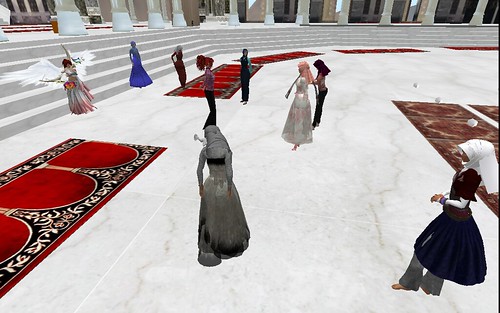We are in week 3 of our Teaching Languages in a Virtual World seesion, which is all about real life places in Second Life and how these can be exploited for learning or practising languages or teaching them.
“Makkah”
We started out in what I call Virtual “Makkah”, which has a replica of Masjid Al-Haram including the Ka’bah, the most sacred place on earth for Muslims. I explained the objectives for this place in SL, which in short are:
- Hajj training for Muslims (non-Muslims always welcome to participate)
- Providing information for Muslims and non-Muslims about Islam
- Interfaith and inter-cultural events (e.g. the Ramadan events, discussions, lectures)
- Lessons (English, Arabic,…)
- Meeting place for Muslims and non-Muslims
Here is the recording of the tour:
This is one of the educational places in SL, which really uses the strength of a 3D virtual world. The alternatives would be to learn the hajj rituals by reading a book with text and illustrations or by attending a presentation with a speaker showing slides. Here, those who want to learn about the hajj and how and when to do certain rituals, they have to actually do it, which is for most people much more memorable than simply reading or hearing or even watching a video about it.
Here are some pictures of the real Makkah.
Al Andalus
This is one of the most beautiful places I have come across in Second Life, a replica of the 13th century Alhambra in Spain. It has also a very vibrant intercultural, interfaith community. They are trying to bring back to life how it was when Christians, Jews and Muslims lived together in relative harmony. There is a church, a mosque and a synagogue, a market, and residential areas that can be rented. They also participate in intercultural or interfaith dialogues and organize events, some of which are educational (e.g. lectures) and some more entertaining (e.g. competition and games). It’s a great place if one wants to be part of a community.
Here you can take a Virtual Walking Tour of the real Alhambra in Al Andalus.
And here are some lovely photographs of the Alhambra.
And this is a video of a project by Dancing Ink Productions called Understanding Islam through Virtual Worlds which shows virtual “Makkah” and Al Andalus and provides some more information about the places.
Language Learning
Now, how can these places be used for language learning or teaching?
Learners, who want to practise their language skills and are interested in religion, history, intercultural events, etc. can join the communities, both of which are very active. The main language is English, but there are many Arabic and French speakers, too.
In a language course, students can prepare a tour for their peers and teacher. These can be short tours or longer ones prepared by a group of students. It can be extended to a project, where they have to collect information from different sources, interview people, compare the places to RL, etc. and then give a “presentation”, which in this case would be a tour of the place.
Different groups of learners from different countries and cultures can be brought together to show each other places related to their culture or country and discuss differences and similarities to foster understanding and practise language skills at the same time.
Over to you:
Do you have more ideas? Have you used real life places in SL for teaching or practising a language? Would you like to describe how you used it or would use it? Would you use it in a face-to-face class or only with distance learners? Why so?
Leave a comment, please.
 In order to promote dialog between Christianity and Islam, Norbert Kebekus from the Archdiocese Freiburg, Christian Kindler from the Department for Media of the Diocese Rottenburg-Stuttgart and I invite to a guided tour of “Virtual Makkah” and the Saint Georg Church in Second Life on 13 October 2009 at 7.30 pm CET. This will be followed by a panel discussion on the educational values of virtual worlds. This event is in German.
In order to promote dialog between Christianity and Islam, Norbert Kebekus from the Archdiocese Freiburg, Christian Kindler from the Department for Media of the Diocese Rottenburg-Stuttgart and I invite to a guided tour of “Virtual Makkah” and the Saint Georg Church in Second Life on 13 October 2009 at 7.30 pm CET. This will be followed by a panel discussion on the educational values of virtual worlds. This event is in German.
